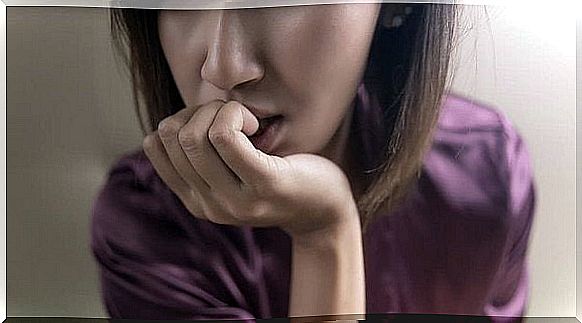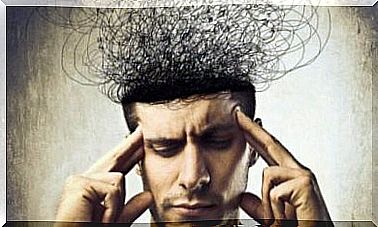Mixed Anxiety Disorder And Depressive Disorder: Definition, Causes And Treatment

Mixed anxiety disorder and depressive disorder have been controversial and not all existing diagnostic classifications include it. It is not that its existence is not recognized, but sometimes it is considered to be a depressive disorder with secondary anxiety properties, and not a single disorder.
The symptoms of mixed anxiety disorder and depressive disorder are anxiety and depression, but none of them are clearly predominant. Nor do they have sufficient intensity to justify a separate diagnosis.
This disorder manifests itself in a mixture of relatively mild symptoms that are often seen in the primary health care service, and the prevalence is even higher in the general population.
The combination of depressive and anxious symptoms leads to a significant deterioration in the function of the affected person.
However, those who oppose this diagnosis have argued that the availability of this diagnosis discourages clinicians from taking the time needed to obtain a complete psychiatric history in a patient. Such a story will allow them to distinguish true depressive disorders from true anxiety disorders.
When is mixed anxiety disorder and depressive disorder diagnosed?
To diagnose it, there must be symptoms of anxiety, and depression of low intensity. In addition, there must be vegetative symptoms such as tremor, palpitations, dry mouth and abdominal pain.
Some preliminary studies have indicated that GPs have a low sensitivity to detect mixed anxiety disorder and depressive disorder syndrome. However, it is possible that this lack of recognition only reflects the lack of an appropriate diagnostic label for these patients.

Symptoms of mixed anxiety disorder and depressive disorder
Clinical manifestations of this disorder combine symptoms of anxiety disorders and symptoms of depressive disorders.
In addition, symptoms of hyperactivity in the autonomic nervous system, such as gastrointestinal upset, are frequent. This is often why patients go to medical outpatient clinics.
DSM-IV research criteria for mixed anxiety disorder and depressive disorder
The Diagnostic and Statistical Manual of Mental Disorders (DSM) presents a number of criteria for diagnosing this disorder. But as we have mentioned, it is only for research purposes. Let’s take a look:
The most important feature of this disorder is a persistent or recurrent dysphoria that lasts at least 1 month. This state of mind is accompanied by several symptoms of the same duration, including at least four of the following:
- Problems with concentration or memory, sleep disturbances, fatigue or lack of energy.
- Acute irritability.
- Recurrent and intense worry.
- Cry easily, or have feelings of hopelessness, pessimism about the future, uselessness and low self-esteem.
- t, expectation of danger.
These symptoms cause significant clinical discomfort or worsening of social, work, or other important activities.
On the other hand, mixed anxiety disorder and depressive disorder should not be diagnosed when the symptoms are due to direct physiological effects of a drug or a medical illness. Or if the person has at any time met the diagnostic criteria for major depressive disorder, persistent depressive disorder, anxiety disorder or generalized anxiety disorder.
This diagnosis is also inappropriate if the criteria for other anxiety or mood disorders are met at the same time, even if they are in partial remission.
It is also necessary that the range of symptoms can not find a better explanation with another mental disorder. Most of the initial information about this disorder is from the primary health care services, where the disorder appears to be more frequent. It probably also has a higher incidence among outpatients.

What is the effect of mixed anxiety disorder and depressive disorder?
The coexistence of a major depressive disorder with an anxiety disorder is very common. Two-thirds of patients with depressive symptoms also have clear symptoms of anxiety. One third of these may meet diagnostic criteria for panic disorder.
Some researchers have reported that 20% to 90% of all patients with anxiety disorders have episodes of major depressive disorder. These data suggest that the coexistence of symptoms of depression and anxiety that do not meet diagnostic criteria for depression or anxiety disorders is very common.
However, at this time, there are no formal epidemiological data on mixed anxiety disorder and depressive disorder. However, some researchers have estimated that the incidence of this disorder in the population is 10%, but in primary care it is 50%. More conservative estimates suggest a prevalence of 1% in the general population.
What causes this disorder?
Four research lines suggest that symptoms of anxiety and depression are linked to identified causes.
First , several researchers have found similar neuroendocrine causes of depressive disorders and anxiety disorders. These include reduction of:
- cortisol response to the adrenocorticotropic hormone
- the growth hormone response to clonidine
- the thyroid stimulating hormone
- the response of prolactin to the thyrotropin-releasing hormone
Second, several researchers have presented data that identify hyperactivity of the norepinephrine system as a relevant factor in the origin of depressive disorders and anxiety disorders in some patients.
Mark Gluck et al. Learning and Memory, 2013.
Specifically, these studies have found that patients with depressive disorders or anxiety disorders who are actively experiencing an anxiety crisis have high concentrations of the norepinephrine metabolite MHPG in their urine, plasma or cerebrospinal fluid.
As with other anxiety and depressive disorders, serotonin and GABA may also be associated with the origin of mixed anxiety disorder and depressive disorder.
Third , many studies have found that serotonergic drugs, such as fluoxetine and clomipramine, are useful in treating both depressive disorders and anxiety disorders.
Finally, several family studies have presented data indicating that anxiety and depressive symptoms are genetically transmitted, at least in some families.
The course of the disturbance and the prognosis
According to current clinical data, it appears that patients may initially have the same likelihood of predominant symptoms of anxiety or predominant symptoms of depression or a proportionate mixture of them.
During the course of the disease, anxiety and depressive symptoms can alternately vary in dominance. A forecast is not yet known.
However, individually, depressive disorders and anxiety disorders tend to become chronic without adequate psychological treatment.
Treatment of mixed anxiety disorder and depressive disorder
Since there are no good studies comparing treatment methods for mixed anxiety disorder and depressive disorder, clinicians tend to provide treatment according to presented symptoms, their severity and their previous experience with the different treatment methods.
Psychotherapeutic approaches can be used for short periods, such as behavioral or cognitive therapies. Nevertheless, some clinicians use a less structured psychotherapeutic approach, such as introspective psychotherapy.
Medication
The pharmacological treatment of mixed anxiety disorder and depressive disorder is usually with anti-anxiety medications, antidepressants or both. Among anxiolytics, some data suggest that the use of triazolobenzodiazepines (eg alprazolam) may be appropriate due to the effectiveness in the treatment of depression associated with anxiety.
Substances that affect the 5-HT receptor, such as buspirone, may also be appropriate. Among antidepressants, serotonergic agents (eg fluoxetine) can be very effective in the treatment of mixed anxiety disorder and depressive disorder.

Psychological treatment
In any case, the preferred treatment for these types of pathologies is cognitive behavioral psychotherapy.
On the one hand, before anything else, it is about the patient reducing the level of physiological activation. This is achieved by breathing techniques (eg diaphragmatic breathing) and relaxation techniques (progressive muscle relaxation, autogenic training, attention, etc.).
Secondly, it is necessary for the patient to improve his mood. This can be achieved in different ways. Behavioral activation therapy can be very effective in this regard.
The idea is that the patient should resume his previous level of activity. To do this, a therapist encourages them to do enjoyable activities, either returning to one or participating in a new one gradually.
Third, a period of psycho-education is useful. During this period, the patient is given an explanation of what is happening to him or her and why. They learn some basic ideas about the properties of anxiety and depression so that they can normalize their experience.
Afterwards , it may be necessary to change some beliefs or thoughts that may be causing the problem. This can be with a cognitive restructuring technique.
As you can see, mixed anxiety disorder and depressive disorder have no specific identity in any diagnostic systems, but it is often found in primary health consultations. It’s pretty common.
It is a disorder that can be treated, and if not treated in time, it can become chronic.
Bibliography:
Bobes García, J. (2001). Senior care workers and depressive mothers in primary care . Barcelona, etc .: Masson.
Derogatis, LR, & Wise, TN (1996). Depressive stressors and employment in primary care . Barcelona: Martinez Roca.









